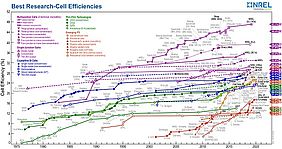Solar panel efficiency is a measurement of a solar panel’s ability to convert sunlight into usable electricity. If the same amount of sunlight shines on two solar panels with different efficiency ratings for the same period of time, the more efficient panel will produce more electricity than the less efficient panel. Most solar panels show efficiencies between 15% and 20%, with outliers on either side of the range. High-quality solar panels can exceed 22% efficiency in some cases, but the majority of photovoltaic panels do not exceed 20%.
Now (2020), scientists at the National Renewable Energy Laboratory (NREL) have designed a solar cell with six junctions which reached an efficiency of nearly 50%, thus setting a new world record for the highest solar conversion efficiency at 47.1%. Scientists used a monolithic, series-connected, six-junction inverted metamorphic structure operated under the direct spectrum at a concentration of 143 Suns. When tuned to the global spectrum, a variation of this structure achieved a 1-Sun global efficiency of 39.2%. Extremely efficient bandgaps for six junctions were designed using alloys of III–V semiconductors. To achieve this goal scientists had to minimize threading dislocations in lattice-mismatched III–V alloys, inhibit phase segregation in metastable quaternary III–V alloys and understand dopant diffusion in complex structures. Further reduction of the series resistance within this structure might even increase efficiencies over 50%. The six-junction solar cell was built for use in concentrator photovoltaics.
Scientists have long been trying to improve the efficiency of solar cells. In 2017, scientists studied the extent to which a fine-tuning of the different electronic gaps involved in MJ stacks could decrease the detrimental effects of series resistance losses for concentration-dependent and independent series resistances with the help of numerical modelling. The results showed that appropriate bandgap engineering could significantly increase conversion efficiency at illumination levels above ~1000 suns and series resistance values typically exceeding 0.02 Ω cm2, because of lower operating current and series resistance losses.
In 2018, researchers demonstrated that a III–V/Si cell could reach similar performances to standard III–V/Ge triple-junction solar cells. The device was fabricated using wafer bonding to permanently join a GaInP/GaAs top cell with a silicon bottom cell. The key issues of III–V/Si interface recombination and silicon's weak absorption were solved using poly-silicon/SiOx passivating contacts and a novel rear-side diffraction grating for the silicon bottom cell. With these combined features, they demonstrated a two-terminal GaInP/GaAs//Si solar cell reaching a 1-sun AM1.5G conversion efficiency of 33.3%.
In 2019, scientists were able to greatly reduce the defect density in the III-V semiconductor layers on the silicon and successfully produced a III-V/Si tandem solar cell with a new efficiency record of 22.3 percent using this direct-growth approach. They directly grew the III-V layers on the silicon solar cell. In this approach, the atomic structure had to be controlled carefully during growth so that the gallium and phosphorous atoms would grow on the correct lattice sites at the interface to the silicon material. Also, the distance between the atoms in the crystal lattice had to be increased in order to produce the gallium arsenide material.
One advantage of the new device is that you can reduce costs by reducing the operating space. This was achieved by deploying a mirror to capture the light and focus the light down to a point. Thus, only a small amount of the material that would be used for a flat-plate silicon cellwas actually used. You also use a lot less semiconductor material by concentrating the light. An additional advantage is that the efficiency goes up as you concentrate the light.
Currently, the main impediment to topping 50% efficiency is to reduce the resistive barriers inside the cell that inhibit the flow of current. Also, cost reduction is one of the major issues regarding the commercialisation of these highly efficient devices.
